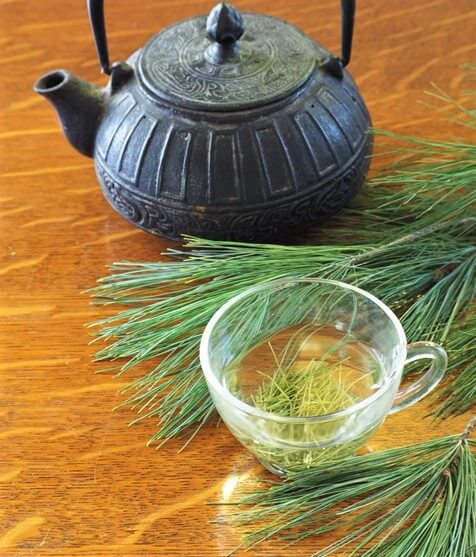
WHY TO MAKE SPRUCE TEA
Did you know your yard is probably filled with plants you didn’t realize were edible? Better still, many are delicious and extremely nutritious.
You don’t even need to wait till the growing season starts to forage in your yard. It turns out your pine and spruce trees are a great resource for winter foraging, though you can make this delicious tea made from spruce needles any time of year. Spruce tea is a great way to continue eating seasonally and locally year-round.

Join the HGS community!
Get the latest green living hacks, foraging tips, special offers & more available only to subscribers.
Spruces and pines have been used as a food source by native peoples for centuries, providing sustenance in the lean months of winter. Spruce needles are a valuable source of vitamin C, helpful for keeping the immune system humming during cold and flu season.
They were used to prevent scurvy by Native Americans when other sources of vitamin C were scarce. They’re reported to contain many other vitamins, minerals, and antioxidants, though I have yet to find a source for these claims.
Pine and spruce needle tea are often used as a remedy for respiratory ailments, and they also contain shikimic acid, the compound used to make the flu-fighting ingredient in Tamiflu. Enjoy a tasty foraged cup of tea and fight colds at the same time? Pretty awesome!
Here’s more on pine needle tea benefits if you have access to pine trees near you. Or try some pine syrup or pine needle tincture the next time a cough strikes. Or if you’re reading this in spring, consider gathering and using some edible pine cones.
There are numerous medicinal trees growing all around us that are worth getting to know.

Related: How to Fight Colds Naturally
Much of the spruce and pine tree is edible, but today we’re just using the spruce needles, in an easy-to-make, nourishing tea. If you want to try foraging other parts of the tree, check out this informative post from Eat The Weeds, which reports you can eat the inner bark, pollen, pitch and cones.
Note that pregnant women are advised to avoid spruce needle tea.
Curious about other medicinal plants you might be growing in your yard? Here’s information on starting a medicinal herb garden, with more than 45 herbs to choose from.
WHAT DOES SPRUCE TEA TASTE LIKE?
In addition to the medicinal possibilities of this refreshing tea, the taste of spruce tea has lots to recommend it. I find the flavor just like a Christmas tree smells. Try it and you’ll know what I mean. That scent that gets in your nose as you decorate your tree is exactly what you taste when you drink spruce tea. Really delightful and uplifting.
As with any herb, it’s best not to overdo, but by all accounts a daily cup of this tasty spruce tea shouldn’t pose any problems for most healthy, non-pregnant tea foragers.
FORAGING SPRUCE NEEDLES FOR SPRUCE TEA
–> The number one rule of foraging: Always consult a good field guide to ensure you’ve got the correct plant.
Check out the best foraging books to consider adding to your home library.
If you haven’t done much foraging, consider taking a class that covers plant identification and best foraging practices. The Herbal Academy’s online foraging course can help you gain confidence identifying and foraging wild edible plants.
Both spruce and pine (as well as fir) trees have needles you can brew tea from, but many find spruce needles have a mellower and more pleasant flavor. To tell a spruce from a pine, just look at how the needles attach to the branch. In short, spruces have needles that attach to the branch individually, while pine needles grow in bunches.


Here’s more on identifying spruce vs fir vs pine, which people often confuse.
–> Be sure you’re not mistakenly collecting needles from a yew, which is highly toxic. Yews are very different and are easy to identify once you know their features: They have wide, flat, bendable needles, darker on top and lighter on bottom and don’t produce cones (they have red fruit).
Here’s lots more on how to identify yews (and why to avoid them) from Eat the Weeds. This video also has a good description of what to look for.
There are enough questions about Norfolk Island Pine and Ponderosa Pine that you should avoid them as well.
Here’s lots more on distinguishing different types of conifers from Iowa State Extension. If all you have handy are pines, no worries! Your tea will taste a little different, but will still make a healthy winter drink when you want it.
WHEN TO MAKE SPRUCE TEA
Your spruce tea will taste different at different times year. Expect your winter spruce tea to have a stronger flavor and the tea made from springtime spruce tips to be lighter and milder.
You can actually nibble the newly-grown tips fresh or use them in cooking like rosemary, but that’s the subject of another post about the tender spring growth from spruce trees known as spruce tips, which you can use in numerous cool spruce tip recipes.
Be on the lookout for spruce tips in spring, as they’re only around a short time. In the meantime, enjoy this tasty tea you can forage all winter long.

HOW TO MAKE SPRUCE TEA
Gather your spruce needles from a tree that won’t have residues from chemical sprays. This likely means avoiding trees in public parks or from yards where homeowners spray their lawns.
If you’re foraging from your Christmas tree, be certain it’s one that wasn’t sprayed, as many commercial operations do spray trees.
Gather needles sparingly, as the tree needs plenty left to stay healthy. I sometimes chop a few inches off branches encroaching on the public sidewalk where the tree in my yard grows.
Note that hot water should be poured over spruce needles rather than boiled with them to preserve medicinal elements.
SPRUCE TEA RECIPE
Ingredients:
1-2 tbsp spruce needles, on or off the branch, rinsed
1 cup freshly boiled filtered water (here’s why I only recommend filtered water)
Optional: A little sweetener if desired (raw honey would be the most medicinally-useful choice)
You can pull your spruce needles off the branch or not, as you prefer. Chopping or crushing the needles will produce a stronger tea and likely will release more of the beneficial compounds. But just dunking a few cut twigs in your cup saves effort and makes straining unnecessary.
Pour water over needles and allow to steep for at least 15 minutes, preferably covered. Longer brews will be stronger flavored, but should also contain more of the useful compounds from the needles.
I like to leave my spruce needle tea brewing for at least a few hours if I’m not in a hurry and don’t mind a cooler drink.
I’ve successfully re-brewed the same spruce needles to prevent an extra trip out in the cold. I just left the little twigs in my cup while I drank and refilled with fresh boiling water. The second cup was a tad weaker, but still very tasty.
MORE FORAGED GOODIES TO KNOW
If you miss foraging in the dead of winter, look no further than your conifers.
In late fall, you may still find edible crab apples hanging on, as well as hackberry fruit and rowanberries.
In late winter and early spring, you’ll start finding numerous edible weeds and medicinal plants including creeping Charlie, dandelions, wild violets, Virginia waterleaf, chickweed, and many more.
Once summer arrives, you’ll find loads more edible flowers worth adding to your next salad or cup of tea. There are also loads of other wild herbs to explore, and numerous perennial herbs to consider for your garden.
And if you want to make as much as you can from the plants in your yard, it’s worth knowing that lavender leaves can be used like their pretty flowers. Here’s what to do with lavender leaves, which are around much longer than the better-known buds.
If you love foraging ingredients for delicious herbal teas, here are some other ideas:
- Elderflower Tea
- Elderberry Tea
- Mulberry Tree Leaf Tea
- Birch Tea
- Wild Violet Tea
- Ginkgo Biloba Tea
- Dandelion Tea (from leaves, flowers, or roots)
- Nettle Leaf Tea
Or check out our collection of wild teas you can forage all season long.
How about you? Ever tried brewing spruce needle tea? If you do, let me know what you think!
Pin to save this spruce tea recipe for later!

Disclaimer: I’m a health enthusiast, not a medical professional. Content on this website is intended for informational purposes only and is not meant to provide personalized medical advice. I draw on numerous health sources, some of which are linked above. Please consult them for more information and a licensed professional for personalized recommendations.
Additional photo credit of spruce needles in pin: FoYu



 Hi, I'm Susannah, a garden geek, energy nerd, and fan of healthy food and natural remedies. Need some simple, practical solutions for living healthier and greener? You've come to the right place! More about me and my green projects
Hi, I'm Susannah, a garden geek, energy nerd, and fan of healthy food and natural remedies. Need some simple, practical solutions for living healthier and greener? You've come to the right place! More about me and my green projects 










































